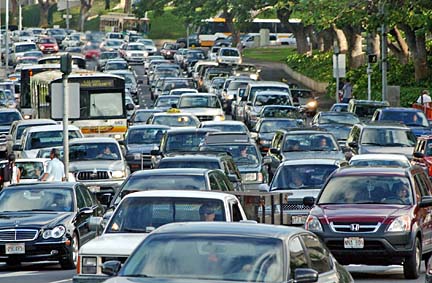

|

Can we dissolve traffic gridlock on Oahu? Maybe, maybe not. But people can sure talk a lot about it.
Fixing the problemProposed short-term traffic solutions» Add a lane to the Kalihi Street "choker" in both directions on H-1» Add a lane between the Liliha Street onramp and Pali Highway offramp on H-1 » Ramp metering » Contraflow along Dillingham Boulevard » Improve traffic-signal timing and coordination » Shift start time for some large schools such as Roosevelt High School, Punahou School and the University of Hawaii at Manoa » Clear and manage accident scenes more efficiently
Long-term solutions» Two reversible lanes on the Nimitz viaduct» Afternoon zipper lane on the H-1 freeway » Peak period contraflow on Pali Highway » Ramp metering on the H-1 freeway » Improve the capacity of Castle Junction » Grade separation at intersections of Kapiolani Boulevard and Kalakaua Avenue and Vineyard Boulevard and Punchbowl Street
Source: Panos Prevedouros, associate professor of the Department of Civil and Environmental Engineering at the University of Hawaii-Manoa
|
There was no consensus on solutions, but plenty of opinions -- many of them related to light rail.
The public forum -- aptly titled "Can We Dissolve Traffic Gridlock?" -- seemed to generate more questions. Among them:
» Sen. Les Ihara (D, Kahala-Palolo): "Is it time for us to have our family budgets reduced a bit in order to contribute a small amount to fund a light rail transit system?"
» Rep. Galen Fox (R, Waikiki-Ala Moana): "Traffic is absolutely a major problem on the island of Oahu and is imminently linked with our housing problem. Honolulu is one of the most perfect cities in the United States for a rail transit system."
Some attendees discovered that Honolulu's traffic problems are far from unique.
Honolulu's traffic problem reflects a nationwide one, said Peter Flachsbart, associate professor of the Department of Urban and Regional Planning. Cheaper cars, population growth and lack of proper land-use planning contribute to traffic, he said.
Developers who want to minimize costs build the least amount of roads to service their projects, he said. "That means a lot of traffic clogging up arterials," Flachsbart added.
Panos Prevedouros, associate professor of the Department of Civil and Environmental Engineering, offered several short- and long-term solutions to mitigate traffic flow on Oahu's roadways.
His ideas include implementing contraflow lanes along Dillingham Boulevard and improving traffic signal timing and coordination. He also proposed double-decks to increase highway capacity and a bus-guideway system as long-term solutions.
The ongoing Waimalu widening project that will extend a portion of the H-1 freeway to six from five lanes is expected to reduce traffic by 30 percent, he said.